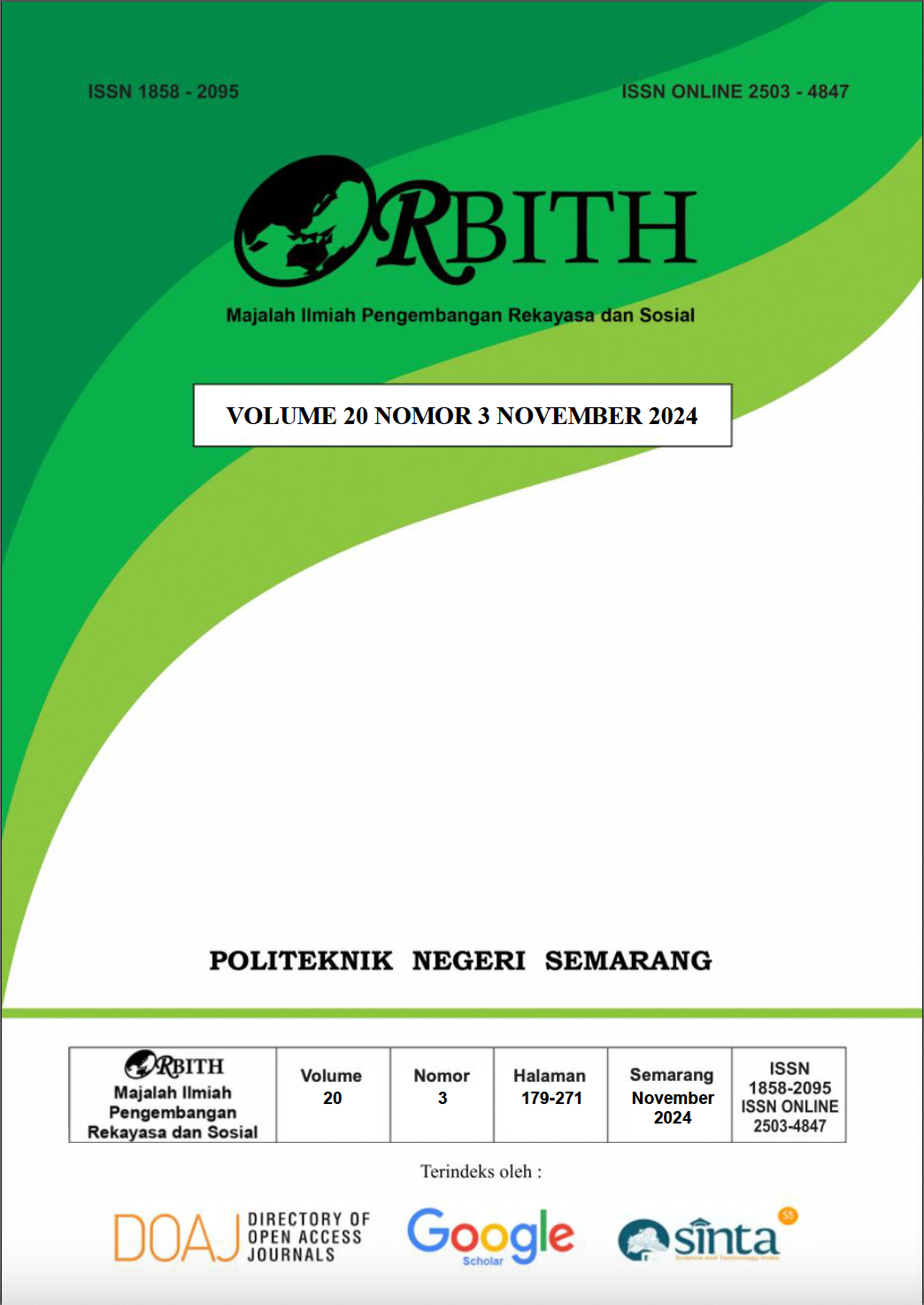OTOMASI PENGERINGAN EMPON - EMPON MELALUI SISTEM KENDALI BERBASIS PLC DAN HMI DENGAN METODE PID DI KAMPUNG JAMU WONOLOPO SEMARANG
DOI:
https://doi.org/10.32497/orbith.v20i3.6245Keywords:
Herbal Medicine, Drying, PLC, PID, TemperatureAbstract
Abstrak Industri jamu, sebagai bagian dari warisan budaya dan tradisi kesehatan masyarakat Indonesia, terus berkembang dengan memanfaatkan berbagai rempah seperti jahe, kencur, dan temulawak. Proses pengolahan rempah, terutama pengeringan, merupakan tahap kritis yang mempengaruhi kualitas dan daya simpan produk akhir. Di Kampung Jamu Wonolopo, Semarang, proses pengeringan masih dilakukan secara tradisional, yang rentan terhadap variasi cuaca. Penelitian ini bertujuan untuk merancang sistem kendali alat pengering empon- empon berbasis PLC dan HMI yang dapat meningkatkan efisiensi dan konsistensi proses pengeringan. Hasil penelitian menunjukkan bahwa integrasi PLC dan HMI memungkinkan otomatisasi dan kontrol yang stabil dengan metode PID, menghasilkan kadar air rata-rata 9% dalam waktu pengeringan sekitar 8 jam pada suhu 65 °C, dengan konsumsi energi 9 kWh per siklus. Kata Kunci: Jamu, Pengeringan, PLC, PID, Suhu Abstract The herbal medicine industry, as part of Indonesia's cultural heritage and traditional community health practices, continues to evolve by utilizing various spices such as ginger, aromatic ginger, and turmeric. The spice processing stage, particularly drying, is a critical phase that affects the quality and shelf life of the final product. In Wonolopo Herbal Village, Semarang, the drying process is still carried out traditionally, making it vulnerable to weather variations. This study aims to design a control system for a spice dryer using PLC and HMI to enhance the efficiency and consistency of the drying process. The results indicate that the integration of PLC and HMI enables automation and stable control through the PID method, achieving an average moisture content of 9% within approximately 8 hours of drying at 65 °C, with an energy consumption of 9 kWh per cycle. Keywords: Herbal Medicine, Drying, PLC, PID, TemperatureReferences
Anwar, S. (2021). Sistem Proteksi Tegangan Sentuh Pada Instalasi Listrik Berbasis Earth Leagage Circuit Breaker (Rcbo). AL ULUM: JURNAL SAINS DAN TEKNOLOGI, 6(2), Article 2.
Ayuningtyas, N. (2018). Sistem Monitoring Berat Pada Alat Pemilah Sampah Logam Dan Nonlogam Dengan Sensor Berat (Load Cell) Berbasis Programmable Logic Controller (Plc) [Other, undip]. https://doi.org/10/BAB_VI.pdf
Budiyanto, M., Setiyono, Y. W., & Effendi, A. (2022). Trainerprogrammable Logic Controller Dilengkapi Human Machine Interface (HMI) Guna Penguatan Praktek Otomasi Industri. Journal of Electrical Power Control and Automation (JEPCA), 5(2), Article 2. https://doi.org/10.33087/jepca.v5i2.81
Byantoro, S. M., Prabowo, D., & Jati, U. S. (2023). Tugas Akhir: Rancang Bangun Sistem Pengaduk Pada Homogenizing Emulsifier Machine Dalam Pembuatan Pupuk Organik Cair [Diploma, Politeknik Negeri Cilacap]. https://elib.pnc.ac.id/739/
Harahap, R., Armansyah, A., Sudaryanto, S., Pramudia, D. T., & Rian, A. F. (2022). Keselamatan Pemakaian Energi Listrik Rumah Tangga Yang Benar di Desa Bandar Rahmat Kecamatan Tanjung Tiram Kabupaten Batu Bara. JET (Journal of Electrical Technology), 7(1), Article 1.
Kartika, K., Asran, A., Erawati, H., Ezwarsyah, E., Putri, R., & Salahuddin, S. (2022). Pelatihan Platform Arduino Bagi Siswa SMA Negeri 1 Baktiya Alue Ie Puteh Aceh Utara. Jurnal Solusi Masyarakat Dikara, 2(1), Article 1.
Putera, A. S. (2017). Simulator Sistem Otomatisasi Dengan Solid State Relay Untuk Pertukaran Sumber Energi Listrik Antara Pln Dan Genset [Thesis, Universitas Medan Area]. https://repositori.uma.ac.id/handle/12 3456789/17784
Risfendra, & Setyawan, H. (2020). Otomasi Industri Dengan Arduino Outseal PLC. UNP PRESS.
Rombekila, A., & Entamoing, B. L. (2022). Prototype Sistem Smart Sistem Smart Home Berbasis IoT dengan Handphone Android Menggunakan NODEMCU ESP32. Jurnal Teknik AMATA, 3(1), Article 1. https://doi.org/10.55334/jtam.v3i1.27 5
Sabtiawan, A. A., & Much Djunaidi, S. T. (2023). Analisis Pengembangan Usaha Bisnis Jamu Tradisional Menggunakan Analisis SWOT Dan QSPM (Studi Kasus: UMKM Produsen Jamu Suti Sehati) [S1, Universitas Muhammadiyah Surakarta]. https://eprints.ums.ac.id/111330/
Sahli, I., Kristanto, I., & Thali, T. C. (2001). Perancangan RS 232 to RS 485 Converter Sistem Network Multidrop. Jurnal Teknik Elektro, 1(1). https://doi.org/10.9744/jte.1.1
Saputra, O. (t.t.). Komunikasi Outseal PLC dengan Smartphone | Ranah Research: Jurnal Penelitian dan Pengembangan Multidisiplin. Diambil 9 Juli 2024, dari https://jurnal.ranahresearch.com/inde x.php/R2J/article/view/539
Subagio, D., Putri, D. K., & Ardi, S. (2017). RANCANG BANGUN PLC TRAINING KIT DIVISI SERVICE PARTS DAN WELDING PRODUKSI BERBASIS PLC OMRON CJ2M-CPU11 | Teknologi. https://technologic.polytechnic.astra.ac.id/index.php/firstjournal/article/view/192
Sufandi, M. R., Kevin, V. L., Hadikusuma, M. I., & Bakar, A. (2023). Purwarupa Proses Pemantauan dan Pengisian Botol Kemasan Berbasis Modul PLC Outseal Dan HMI Haiwell. Jurnal ELIT, 4(2), Article 2. https://doi.org/10.31573/elit.v4i2.579
Sunar, S., & Subagiyo, S. (2020). Peningkatan Keaktifan dan Ketrampilan Membuat PCB Kelas XII TAV SMK Negeri 1 Semarang. Edu Elektrika Journal, 9(2), Article 2. https://doi.org/10.15294/eej.v9i2.37973
Downloads
Published
Issue
Section
License
Authors who publish with this journal agree to the following terms:Authors retain copyright and grant the journal right of first publication with the work simultaneously licensed under a Creative Commons Attribution License that allows others to share the work with an acknowledgement of the work's authorship and initial publication in this journal.
Authors are able to enter into separate, additional contractual arrangements for the non-exclusive distribution of the journal's published version of the work (e.g., post it to an institutional repository or publish it in a book), with an acknowledgement of its initial publication in this journal.
Authors are permitted and encouraged to post their work online (e.g., in institutional repositories or on their website) prior to and during the submission process, as it can lead to productive exchanges, as well as earlier and greater citation of published work (See The Effect of Open Access).






